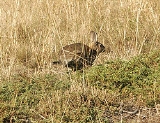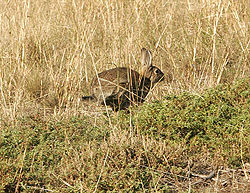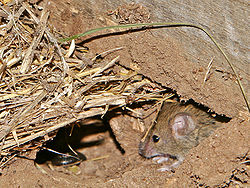
Vermin
Encyclopedia


Disease
A disease is an abnormal condition affecting the body of an organism. It is often construed to be a medical condition associated with specific symptoms and signs. It may be caused by external factors, such as infectious disease, or it may be caused by internal dysfunctions, such as autoimmune...
. Since the term is defined in relation to human activities, which species are included will vary from area to area and even person to person. The term itself derives from the Latin
Latin
Latin is an Italic language originally spoken in Latium and Ancient Rome. It, along with most European languages, is a descendant of the ancient Proto-Indo-European language. Although it is considered a dead language, a number of scholars and members of the Christian clergy speak it fluently, and...
vermis, meaning worm, and originally had reference to the vermiform larva
Larva
A larva is a distinct juvenile form many animals undergo before metamorphosis into adults. Animals with indirect development such as insects, amphibians, or cnidarians typically have a larval phase of their life cycle...
e of certain insects, many of which infest foodstuffs. The term
Term
Term may refer to:*Term or terminology, a noun or compound word used in a specific context meaning*Term or terminal emulator, a program that emulates a video terminal...
'Varmint' dates as early as the first half of the 16th century (ca. 1530-1540s).
Spelling distinction
Varmint or varmit is an American-English colloquialismColloquialism
A colloquialism is a word or phrase that is common in everyday, unconstrained conversation rather than in formal speech, academic writing, or paralinguistics. Dictionaries often display colloquial words and phrases with the abbreviation colloq. as an identifier...
, particularly common to the American east and South-east within the nearby bordering states of the vast Appalachia
Appalachia
Appalachia is a term used to describe a cultural region in the eastern United States that stretches from the Southern Tier of New York state to northern Alabama, Mississippi, and Georgia. While the Appalachian Mountains stretch from Belle Isle in Canada to Cheaha Mountain in the U.S...
region. The term describes farm pests which raid farms as opposed to infest farms — mainly predators such as foxes, weasels, and coyote
Coyote
The coyote , also known as the American jackal or the prairie wolf, is a species of canine found throughout North and Central America, ranging from Panama in the south, north through Mexico, the United States and Canada...
s, sometimes even wolves or rarely, bears, but also, to a lesser degree, herbivores and burrowing animals that directly damage crops and land.
Although this version of the word Vermin is not a prevalent term in Standard Written English
Standard Written English
Standard written English refers to the preferred form of English as it is written according to prescriptive authorities associated with publishing houses and schools. As there is no regulatory body for the English language, there is some disagreement about correct usage, though there is enough...
, it is a common descriptor for certain kinds of weapons and pest control
Pest control
Pest control refers to the regulation or management of a species defined as a pest, usually because it is perceived to be detrimental to a person's health, the ecology or the economy.-History:...
situations in the Appalachian and nearby states and the American west and south-west which have adopted terms such as "varmint rifle
Varmint rifle
Varmint rifle is an American English term for a small-caliber firearm or high-powered air gun primarily used for varmint hunting — killing non-native or non-game animals such as rats, house sparrows, starling, crows, ground squirrels, gophers, jackrabbits, marmots, groundhogs, porcupine,...
", "varmint hunting" and "varmit hunt".
Scope of meanings
Disease-carrying rodentRodent
Rodentia is an order of mammals also known as rodents, characterised by two continuously growing incisors in the upper and lower jaws which must be kept short by gnawing....
s and insect
Insect
Insects are a class of living creatures within the arthropods that have a chitinous exoskeleton, a three-part body , three pairs of jointed legs, compound eyes, and two antennae...
s are the usual case, but the term is also applied to larger animals—especially small predators — on the basis that they exist out of balance
Ecosystem
An ecosystem is a biological environment consisting of all the organisms living in a particular area, as well as all the nonliving , physical components of the environment with which the organisms interact, such as air, soil, water and sunlight....
with a human-defined (desired) environment
Natural environment
The natural environment encompasses all living and non-living things occurring naturally on Earth or some region thereof. It is an environment that encompasses the interaction of all living species....
, where they are normally accused of consuming excessive resources
Natural resource
Natural resources occur naturally within environments that exist relatively undisturbed by mankind, in a natural form. A natural resource is often characterized by amounts of biodiversity and geodiversity existent in various ecosystems....
(such as feeding on crops, from a farmer
Farmer
A farmer is a person engaged in agriculture, who raises living organisms for food or raw materials, generally including livestock husbandry and growing crops, such as produce and grain...
's point of view).The American Crow
American Crow
The American Crow is a large passerine bird species of the family Corvidae. It is a common bird found throughout much of North America...
is widely hated by farmers because of crop deprivation. Pigeons, which have been widely introduced in urban environments, may be considered vermin, or, pejoratively, "flying rats". Some varieties of snake are also referred to as vermin from time to time.
The term is also used as an extremely pejorative characterization of a particular class
Social class
Social classes are economic or cultural arrangements of groups in society. Class is an essential object of analysis for sociologists, political scientists, economists, anthropologists and social historians. In the social sciences, social class is often discussed in terms of 'social stratification'...
or group
Ethnic group
An ethnic group is a group of people whose members identify with each other, through a common heritage, often consisting of a common language, a common culture and/or an ideology that stresses common ancestry or endogamy...
of people as inferior and subhuman
Dehumanization
Dehumanization is to make somebody less human by taking away his or her individuality, the creative and interesting aspects of his or her personality, or his or her compassion and sensitivity towards others. Dehumanization may be directed by an organization or may be the composite of individual...
, and often considered social parasites
Parasitism (social offense)
Social parasitism is a charge that is leveled against a group or class in society which is considered to be detrimental to the whole by analogy with biologic parasitism .-General concept:...
. Application of the term can be wide, having been applied over the centuries in different language
Language
Language may refer either to the specifically human capacity for acquiring and using complex systems of communication, or to a specific instance of such a system of complex communication...
s, to various groups, and its use is usually based on a perception
Perception
Perception is the process of attaining awareness or understanding of the environment by organizing and interpreting sensory information. All perception involves signals in the nervous system, which in turn result from physical stimulation of the sense organs...
that the target group's views are "disease-like," or that such groups exist out of sociological balance
Sociology
Sociology is the study of society. It is a social science—a term with which it is sometimes synonymous—which uses various methods of empirical investigation and critical analysis to develop a body of knowledge about human social activity...
with the common society.
Deterioration of balance
Species can develop into vermin if introduced into regions where they find favourable living conditions, and if they face few or no natural enemies there. In such cases, humans often choose to fill the role of the predator to limit the danger to the environment. A prime example of vermin is goatGoat
The domestic goat is a subspecies of goat domesticated from the wild goat of southwest Asia and Eastern Europe. The goat is a member of the Bovidae family and is closely related to the sheep as both are in the goat-antelope subfamily Caprinae. There are over three hundred distinct breeds of...
s on the Galápagos Islands
Galápagos Islands
The Galápagos Islands are an archipelago of volcanic islands distributed around the equator in the Pacific Ocean, west of continental Ecuador, of which they are a part.The Galápagos Islands and its surrounding waters form an Ecuadorian province, a national park, and a...
. Rat
Rat
Rats are various medium-sized, long-tailed rodents of the superfamily Muroidea. "True rats" are members of the genus Rattus, the most important of which to humans are the black rat, Rattus rattus, and the brown rat, Rattus norvegicus...
s, mice, and cockroaches are common urban and suburban vermin. Cats, introduced to countries such as Australia, have killed more indigenous wildlife than any other introduced animal, to the extent that they have been implicated in the extinction of many small mammals and amphibians.
United Kingdom
Under Tudor "vermin laws" many creatures were seen as competitors for the produce of the countryside and bounties were paid by the parish for their carcasses. The declaration of the Red KiteRed Kite
The Red Kite is a medium-large bird of prey in the family Accipitridae, which also includes many other diurnal raptors such as eagles, buzzards, and harriers. The species is currently endemic to the Western Palearctic region in Europe and northwest Africa, though formerly also occurred just...
as vermin led to its decline to the point of extinction in the UK by the 20th century. However, the Red Kite is being reintroduced by the trans-location of breeding pairs from Europe.

